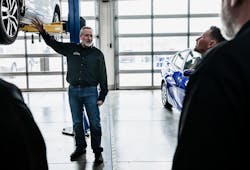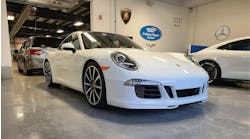Randy Miller, a veteran of nearly four decades in the collision repair industry, has refined his shop’s estimating process for years now.
And he’s had to. After all, the complexity of vehicles is so much greater than when Miller began his career in the 1970s. And, most shops—not unlike Miller’s in Austin, Minn.—only have a couple estimators at their disposal.
“I’ve been doing this for almost 40 years now,” notes Miller, the president of Collision Specialists Inc., who has earned widespread acclaim in the industry for his shop’s estimating process. “In the beginning, it was just a quick write-out, handwritten type of estimate. … You kind of guessed on how much materials would be.”
Nowadays, ballpark figures won’t cut it.
“You’ve got to be really serious, and every dollar counts these days,” Miller says.
The biggest key, in his experience, is to schedule out estimates. That way, estimators won’t be rushed, and shops experience few costly oversights. Miller looks at it this way: If you had a sore tooth, you wouldn’t simply show up at the dentist and expect to have your issue fixed in one day; you would expect to be forced to schedule a dental exam.
“The biggest thing is scheduling your estimates out,” Miller says. “The reason we do that? First off, a lot of times, the emotion goes away with the customer. If [the accident] just happened, the customer’s very emotional.
“We realized that what’s going on in the shop work area is directly affected by the estimating and scheduling process.”
In some respects, handling estimates effectively is easier than ever. Then again, with shops often saddled with budget constraints, estimators are expected to track more work than ever these days.
“It’s all the procedures around the estimate itself that helps create a smooth process,” Miller says. “It has to be worked on continually, because of all the changes in the industry.”
FenderBender spoke with multiple industry veterans, seeking the keys to estimating as effectively as possible in 2019. Here’s an in-depth look at their estimating processes.
COMMUNICATION WITH TECHS
Many body shops foster quick, non-verbal communication between their estimators and technicians by marking up vehicles—with green notes on a vehicle windshield representing areas requiring a repair, with another color, such as pink, noting vehicle damage that’s unrelated to a scheduled repair.
At Miller’s shop, he has established checkpoints throughout his shop floor that aid communication among staff members.
“We have steps all throughout the process,” says Miller, whose business produces $2 million in annual revenue. “There are sheets [and] these sheets follow the car throughout the whole shop. The blueprinter has a sheet to fill out, and he gives it to the estimator. The estimator takes his sheet, fills it out, and then he gives it to the parts guy.”
To inspire conversations among the entire staff, Miller has much of his staff get involved in the estimation process. Every vehicle—even if it’s a simple fender job—receives the attention of multiple Collision Specialists staffers.
“When the vehicle comes in and is disassembled, we walk around it as a team,” Miller says. “We usually do it in the morning, right away.
“We’ll walk around every vehicle that comes in the shop. … And, at that point in time is where the estimate is completely locked up and done.
“Eyeballs are on the vehicle, from the painter, to the body tech, to the detailer. They’re all looking at this car, going, ‘OK, this is what we’re doing with the car.’ You might have a detailer saying, ‘What do you want me to do with all the overspray from the last guy that painted on this car?’ The body tech might go, ‘How many hours for that dent?’ And the estimator says, ‘I’ve got 12.’”
That estimating procedure ensures that the crew at Collision Specialists works together, as a unit, Miller says. Several shop floor employees are involved, and, as he says, they all feel like they have “skin in the game.”
Overall, here’s how Miller incorporates his estimating philosophies and puts his preferred processes in action:
Schedule estimates.
Miller feels scheduling out estimates is paramount nowadays. By scheduling them, it helps ensure that his estimators rarely write a rushed estimate.
“What we do is schedule [estimates] for a one-hour period of time,” says Miller, whose shop has a 97.2 CSI score, so, “they know that we’re doing a good, thorough job for them. And, by doing that, we have time to wash their vehicle.
“If we have 10 people walk in and they all want an estimate right now, we’re going to write the sheets terribly because we’re going to take 20 minutes to do them, and we’re not going to have a complete estimate.”
Do group walk-arounds.
As mentioned earlier, Miller also swears by having your staff perform vehicle walkarounds as a team. That way, very few repair issues will escape your shop’s attention early in the repair process.
“We’ll walk around every vehicle that comes in the shop—it doesn’t matter if it’s a simple fender job or something small,” Miller says.
Utilize Modern Technology.
Considering all the innovative technology that’s at collision repairers’ fingertips these days, the shop operators that FenderBender spoke to say it’s misguided to not use them all. Miller recommends utilizing 3D measuring systems, since they can rule out any bent vehicle frames early in the estimating process.
He has also made pre- and post-repair scanning a key element of his shop’s estimating process. Diagnosing, or pre-scanning, can educate a body shop’s staff on the full condition of a vehicle and the ideal order of procedures that need to be performed on it, Miller says.
“It starts with us educating [the customer] that we will be pre-scanning and post-scanning their vehicle,” Miller explains, “and informing them that there could be prior codes that had occured before their accident and that the insurance company could deny paying for. Diagnosing the vehicle … helps us get up front parts we need for many of the electronic devices on today’s vehicle.”
Document everything.
Considering that insurance companies typically seek to keep repair bills reined in as much as possible, it’s in the best interest of body shops to take as many photos of vehicle damage as possible.
Plus, by making photos part of the estimating process, customers can quickly be informed when, and if, repair supplements are needed.
Essentially, by providing clients and insurers with prompt photos or screenshots, it can present your shop as a business that prides itself on working transparently.
INSURANCE NEGOTIATIONS
Like Miller, Dan Sjolseth has, for years, pondered how to streamline the estimating process as much as possible.
“Years ago,” says Sjolseth, the owner of Superior Service Centers in greater Minneapolis, “the way we’d process the work was, we’d grab the keys and write what we could see. Because we were trained by insurance companies to only write what you can see; don’t write anything else.
“We would disassemble it, we’d discover more damage, we’d order necessary parts.
“We were always on the run. … There were times we’d have five, six supplements on vehicles.”
Those frustrations are now largely a thing of the past for Sjolseth, whose shops—which handle both collision repair and mechanical work—currently produce $7.5 million in combined annual revenue ($4.6 million of which is from collision repair work).
Sjolseth has learned how important it is to document all vehicle damage, utilizing modern photo estimating, for example. With such technological advances, estimating is not only more accurate, but also, an insurance negotiation process that used to take days has now been whittled down to mere minutes.
“Some of the innovations on that end have come from insurance companies themselves,” notes Tony Hoffman, the general manager at Superior Service Center. “They essentially use an app like Skype on your phone. And, your supplements are essentially instantaneous with them now.
“You get all your parts lined up, you get your supplement done, you fire up the app, and somebody jumps on and you Skype with them and they take screenshots while you’re doing that. And the supplement’s done in minutes.”
If body shops want to quickly silence arguments from insurers regarding repair bills, modern 3D measuring systems can also offer assistance. After all, if your shop’s staff were to find out, midway through a repair, that a vehicle’s frame was bent, that could cause unwanted delays in the repair process, and with insurers. That’s why, at Miller’s shop in Austin, Minn., the staff measures vehicles early on in the repair process.
“The insurance company, we’ve trained them to pay us for what we call ‘diagnosing the vehicle,’” Miller says. “And they’ll pay us 20 minutes or half an hour to do that.
“There are arguments [from some in the industry] that you’re not going to get paid for that. Well, you know what? What you’re doing, when you measure a vehicle up front, is [assessing] all the problems with that vehicle.”
Miller also feels that diagnostic scanning can help a shop justify the repairs it does, as well as labor times and parts replacement. Collision Specialists Inc. has its own scan tools and currently uses a remote vendor. And, Miller envisions a time in the near future in which the Minnesota shop possesses all manufacturers’ scan tools.
“We have a set minimum rate for pre-scan and for post-scanning on vehicles,” Miller notes. “We did this by doing our own survey on mechanical shops and dealers in our local area. It’s understood that there could be additional costs due to programming, dealer-only services, and transportation costs.”




